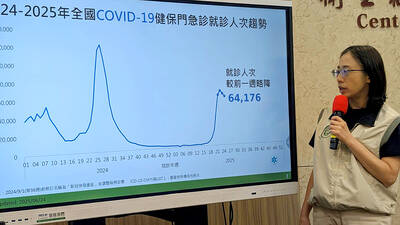The Ministry of Health and Welfare has modified food additive standards to increase potassium iodide concentrations in iodized salt after the Health Promotion Administration (HPA) found that 51.2 percent of Taiwanese lack sufficient iodine intake.
Amendments to the Standards for Specification, Scope, Application and Limitation of Food Additives is to require potassium iodide concentration in iodized salt to be increased from the current range of 12mg/kg to 20mg/kg, to 20mg/kg to 33mg/kg and would be enforced after six months, the HPA said.
The ministry’s Food and Drug Administration (FDA) said iodized salt manufacturers would face a fine of between NT$30,000 and NT$3 million (US$90,807) if they fail to meet the standards after they come into effect.
HPA Director-General Chiou Shu-ti (邱淑媞) said that a 2013 survey showed the median urinary iodine concentration of people above six years old was only 99 micrograms per liter — below the minimal concentration of 100 micrograms per liter recommended by the WHO — adding that iodine is a necessary nutrient to maintain healthy functions of the thyroid gland.
Thyroid hormone deficiency can lead to fatigue; intolerance to cold; goiter and obesity caused by slow metabolism; mental and physical developmental delay in children and teenagers; impairment in mental function, such as memory loss, in adults; hypophrenia (mental deficiency); extreme fatigue; depression and slowdown in mental responses, the HPA said.
Long-term iodine deficiency can also cause disruptions in the menstrual cycle and infertility in women, or cause even more serious consequences in pregnant women, such as miscarriage, still birth and congenital abnormalities, it added.
As for concerns about whether people would consume excessive levels of iodine after the policy is enforced, the HPA said if an individual consumes 6g of salt per day — the maximum daily consumption recommend by the administration — the person would be consuming an iodine supplement of about 120 to 198mg, much lower than the amount of iodine that would be taken by consuming a kelp knot, so the risks of iodine over-consumption from salt is low.

Prosecutors in New Taipei City yesterday indicted 31 individuals affiliated with the Chinese Nationalist Party (KMT) for allegedly forging thousands of signatures in recall campaigns targeting three Democratic Progressive Party (DPP) lawmakers. The indictments stem from investigations launched earlier this year after DPP lawmakers Su Chiao-hui (蘇巧慧) and Lee Kuen-cheng (李坤城) filed criminal complaints accusing campaign organizers of submitting false signatures in recall petitions against them. According to the New Taipei District Prosecutors Office, a total of 2,566 forged recall proposal forms in the initial proposer petition were found during the probe. Among those

ECHOVIRUS 11: The rate of enterovirus infections in northern Taiwan increased last week, with a four-year-old girl developing acute flaccid paralysis, the CDC said Two imported cases of chikungunya fever were reported last week, raising the total this year to 13 cases — the most for the same period in 18 years, the Centers for Disease Control (CDC) said yesterday. The two cases were a Taiwanese and a foreign national who both arrived from Indonesia, CDC Epidemic Intelligence Center Deputy Director Lee Chia-lin (李佳琳) said. The 13 cases reported this year are the most for the same period since chikungunya was added to the list of notifiable communicable diseases in October 2007, she said, adding that all the cases this year were imported, including 11 from

China might accelerate its strategic actions toward Taiwan, the South China Sea and across the first island chain, after the US officially entered a military conflict with Iran, as Beijing would perceive Washington as incapable of fighting a two-front war, a military expert said yesterday. The US’ ongoing conflict with Iran is not merely an act of retaliation or a “delaying tactic,” but a strategic military campaign aimed at dismantling Tehran’s nuclear capabilities and reshaping the regional order in the Middle East, said National Defense University distinguished adjunct lecturer Holmes Liao (廖宏祥), former McDonnell Douglas Aerospace representative in Taiwan. If

The Mainland Affairs Council (MAC) today condemned the Chinese Communist Party (CCP) after the Czech officials confirmed that Chinese agents had surveilled Vice President Hsiao Bi-khim (蕭美琴) during her visit to Prague in March last year. Czech Military Intelligence director Petr Bartovsky yesterday said that Chinese operatives had attempted to create the conditions to carry out a demonstrative incident involving Hsiao, going as far as to plan a collision with her car. Hsiao was vice president-elect at the time. The MAC said that it has requested an explanation and demanded a public apology from Beijing. The CCP has repeatedly ignored the desires